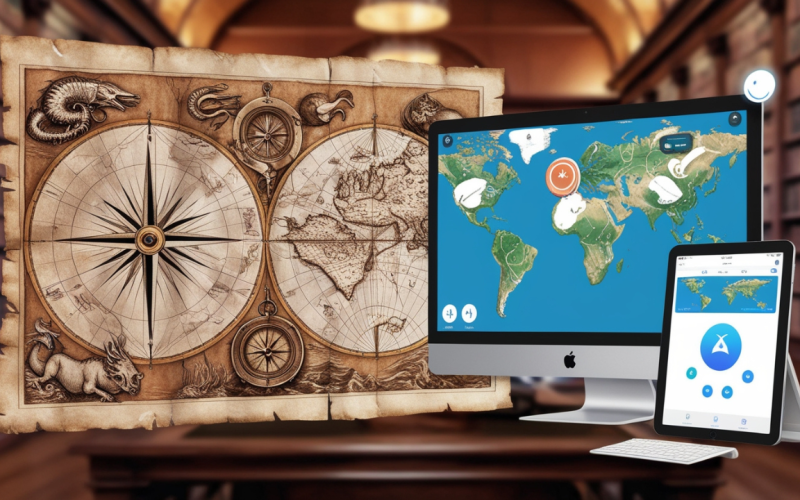Intro about Anna Scherhand Travel Blog
Anna Scherhand Travel Blog, Maps are more than just navigational tools; they are windows into the past, reflecting not only geography but also the cultural and political landscapes of different eras. For centuries, maps have been created to document lands, borders, and discoveries, each one capturing a snapshot of how people understood their world at the time.
Collections like the David Rumsey Historical Map Collection are especially valuable for preserving these unique artifacts, offering insight into everything from ancient cities to early American states.
By examining historical maps, we gain a richer understanding of the evolution of human civilization, our changing knowledge of the planet, and the influences of culture and politics on cartography.
Key Takeaways
- Historical maps provide invaluable insights into past geographies and cultural perspectives.
- The David Rumsey Collection includes maps spanning North America to South America, showcasing diverse landscapes and historical events.
- Atlases cover various regions, offering detailed maps that reflect the unique topographical features of cities, states, and entire continents.
- Pocket maps and wall maps served different functions for travelers, educators, and policymakers alike.
- Modern digital atlases make historical maps more accessible to a global audience, transforming the way we learn about past societies.
The Fascination with Historical Maps
The Importance of Historical Maps in Understanding the Past
Historical maps are not only valuable for their geographical information but also for the insight they offer into historical events and social values. By examining old maps, we can observe how borders shifted due to treaties, conflicts, or colonial expansion.
Maps also provide visual evidence of economic priorities, trade routes, and migration patterns over time. For instance, the prominence of certain regions or cities on maps reflects their importance as cultural or economic hubs in their respective eras.
Why People Value Historical Maps
Historical maps hold immense educational and cultural value. They give us a snapshot of the world as understood in different historical contexts, allowing us to trace the development of territories and the spread of knowledge.
Through maps, we gain insight into how people viewed different parts of the world, and they help us understand the roots of modern-day borders and cities. Collections like the David Rumsey Map Collection contain a variety of maps, including road maps, pocket maps, and wall maps, each serving different practical and informational purposes over time.
The David Rumsey Historical Map Collection
An Overview of the David Rumsey Collection
The David Rumsey Historical Map Collection is one of the world’s largest and most comprehensive archives of maps. With over 150,000 maps spanning various regions and historical periods, this collection is a must-see for map enthusiasts and historians alike. It includes maps from North America, South America, and beyond, each capturing unique details about these regions’ landscapes, infrastructure, and cultural centers.
Types of Maps in the Rumsey Collection
The David Rumsey Collection includes many types of maps, such as separate maps that cover individual regions or topics and atlas maps that group several maps together for comprehensive analysis. This collection provides a window into the geographical knowledge of past eras, displaying everything from simple road maps to detailed topographical maps.
Separate Maps and Their Purpose
Separate maps in the Rumsey Collection focus on specific themes or areas. These maps often reflect a single city, state, or geographic feature in detail, making them valuable resources for understanding particular locations’ topography and infrastructure. They capture detailed information, like waterways, mountains, and major roads, useful for educational purposes.
Bound Atlas Maps for Comprehensive Views
Atlas maps are often bound together to provide a complete view of a particular region or topic. For instance, an atlas of the state might include maps of each county, providing detailed geographic, economic, and demographic information. In contrast, world atlases cover multiple countries and continents, reflecting global knowledge at the time of publication.
Types of Maps in Historical Collections
Different Kinds of Maps and Their Functions
Maps serve various purposes, and historical collections like Rumsey’s showcase the diversity in map design and function. Below are some prominent types:
- Road Maps: These are designed to show major travel routes, connecting cities and states. Historically, they were crucial for trade and travel, helping people navigate from one region to another.
- Pocket Maps: These smaller maps were easy to carry, making them ideal for travelers needing a quick reference. Pocket maps offered a condensed view of key locations or roadways, suitable for daily use.
- Manuscript Maps: Manuscript maps were often created by hand for specific purposes, such as military planning or scientific research. These maps are rare and valuable for their unique, often one-of-a-kind details.
- Wall Maps: These larger maps were typically used for educational purposes, displayed in schools or public buildings. Wall maps covered large areas and often included detailed illustrations of landscapes and cities.
Specialized Maps and Atlases
Some maps were designed to serve specific purposes, such as navigation or historical analysis. These include maritime charts for ocean navigation and topographical maps that highlight the land’s physical features.
Atlas of the United States vs. World Atlases
Atlases covering the United States provide a closer look at its states and territories, often including maps of each county. World atlases, on the other hand, cover multiple regions and provide a broader view of global geography, often containing sections for different continents or countries.
Topographical Maps and Their Unique Details
Topographical maps represent the land’s surface, showing mountains, valleys, and other natural features. They are essential for understanding the physical landscape of an area and were especially useful in the development of infrastructure and planning in historical times.
The Role of Atlases in Historical Mapping
The Purpose of Atlases in Historical Times
Atlases have been invaluable for both practical and educational purposes throughout history. They organize information into collections, allowing people to reference specific regions or topics without needing multiple separate maps. Atlases like the Atlas Universel de Geographie and the World Geo-Graphic Atlas are notable for their comprehensive coverage and visual appeal, often including detailed illustrations.
Use of Atlases by Government and Institutions
Many atlases were produced under the supervision of government agencies or scientific institutions, ensuring accuracy and relevance for official use. For example, the United States Geological Survey and the Department of the Interior produced atlases to guide infrastructure projects and land surveys.
The Academy of Sciences and Its Contributions
The Academy of Sciences has contributed significantly to mapmaking, producing atlases that reflect the latest knowledge in geography, astronomy, and topography. These atlases are essential for understanding how scientific discoveries influenced cartography.
Key Historical Mapmakers and Their Contributions
Important Figures in Cartography
Some of history’s most famous mapmakers contributed significantly to the field of cartography, creating maps that remain valuable today. Figures like David Rumsey, Karl von, and Juan de la Cruz Cano are recognized for their expertise and dedication to documenting the world through maps.
David Rumsey and His Historical Legacy
David Rumsey is best known for his extensive map collection, which showcases maps from various regions and historical periods. His efforts have preserved countless maps, making them accessible to historians, educators, and the public.
Juan de la Cruz Cano and His Maps of the Known World
Juan de la Cruz Cano created maps that reflect the known world of his time, particularly focusing on Spanish territories and the Americas. His work is notable for its accuracy and detail, especially considering the limited knowledge available during his era.
The Influence of Digital Collections on Map Accessibility
Digitization of Historical Maps for Global Access
Digital platforms have revolutionized how we access historical maps. Collections like the David Rumsey Map Collection are now available online, allowing people from around the world to explore historical maps without needing physical access to the archives. This digitization has made historical maps more accessible to students, researchers, and map enthusiasts.
The Role of Digital Platforms in Preserving Cartographic Heritage
By preserving maps digitally, institutions ensure that these valuable artifacts are safe from physical deterioration. Digital platforms also allow for interactive features, such as zooming in on specific map details and comparing maps from different periods.
The Evolution of Cartography: From Hand-Drawn Maps to Digital Archives
Early Methods of Mapmaking and Materials Used
In earlier centuries, maps were hand-drawn using simple tools. These maps were often inaccurate by today’s standards, yet they provided a starting point for understanding geography. Cartographers used materials like parchment, ink, and eventually printing presses to produce maps that were both artistic and informative.
The Shift from Manuscript Maps to Printed Atlases
As printing technology advanced, cartographers shifted from hand-drawn maps to printed atlases. This made maps more accessible and easier to reproduce, allowing maps to reach a wider audience. Atlases became popular because they provided multiple maps in a single volume, making it easier to study different regions.
Key Features of Historical Maps That Shape Our Understanding of the Past
Symbolism and Artistic Details in Early Maps
Early maps often included decorative elements and symbols. Mythological figures, constellations, and cultural symbols were common in historical maps, reflecting the beliefs and artistic styles of the time. These elements add a layer of historical context to the maps, offering insights into cultural values and worldviews.
Political and Cultural Markers in Historical Maps
Many historical maps include political markers, such as flags or boundaries, to indicate control over specific areas. Cultural markers, like illustrations of significant buildings or landmarks, provide additional context, showing the importance of certain regions or cities.
Educational Uses of Digital Historical Maps
Enhancing History and Geography Curricula with Digital Maps
Digital maps bring history and geography to life in classrooms. Teachers can use interactive maps to help students understand historical events, geographical changes, and cultural shifts. Digital maps offer a hands-on learning experience that is often more engaging than traditional textbooks.
Using Map Comparisons for Visual Learning in Classrooms
Comparing historical and modern maps side by side allows students to see changes in borders, infrastructure, and urban development. This visual approach helps students understand the impact of historical events and the passage of time on geographic boundaries.
Technical Aspects of Digitizing Maps
The Process of Scanning and Digitizing Maps for Online Use
Digitizing maps involves carefully scanning each map to preserve its details, colors, and dimensions. High-resolution scanning is essential to capture intricate details, allowing users to zoom in and explore each map closely.
Challenges in Preserving Color and Detail in Digital Formats
Maintaining the original color and details of historical maps is challenging during digitization. Colors can fade over time, and the digitization process requires specific lighting and calibration to ensure the digital image matches the original as closely as possible.
Contributions of Major Institutions to Digital Map Collections
The Role of the Library of Congress in Map Preservation
The Library of Congress holds one of the largest map collections in the world, including rare maps from different periods. By digitizing these maps, the Library of Congress preserves them for future generations, making them accessible to researchers and the public alike.
National Archives and Its Collection of Historical Maps
The National Archives also plays a significant role in preserving historical maps, particularly those related to U.S. history. These maps document everything from early exploration routes to territorial boundaries, providing valuable resources for historians.
Practical Applications of Historical Maps Today
Historical Maps in Genealogical Research
Genealogists use historical maps to trace family histories and locate ancestral lands. These maps provide context for family histories, showing how communities and regions evolved over time.
Real Estate and Urban Development Insights from Old Maps
Real estate professionals and urban developers study historical maps to understand how land use and urban planning have evolved. Maps reveal trends in housing development, transportation, and public infrastructure.
The Influence of Digital Collections on Map Accessibility
Digitization of Historical Maps for Global Access
Digital platforms have revolutionized access to historical maps, allowing people worldwide to explore these resources online. The David Rumsey Map Collection and others are now available to everyone, making it easy for students, researchers, and history enthusiasts to explore maps without visiting physical archives.
Digitization also allows for the integration of historical maps into educational resources, giving teachers and students a valuable tool for understanding geography and history. Researchers can analyze maps in detail, comparing regions, borders, and infrastructure changes across different periods.
The Role of Digital Platforms in Preserving Cartographic Heritage
Digitization protects maps from physical deterioration, ensuring that these artifacts are preserved for future generations. Digital platforms enable users to zoom in on specific map details, enhancing the educational value of each map.
Interactive Tools and Comparative Analysis
Digital platforms often provide interactive tools that allow users to compare maps from different eras, helping researchers understand changes in borders, landscapes, and cities. By overlaying historical maps onto modern ones, users can visualize urban growth and geographic shifts over time.
Engaging the Public Through Online Map Collections
Online collections, like those provided by the Library of Congress and David Rumsey, engage the public with interactive exhibits. Virtual tours, map galleries, and social media updates make historical maps accessible and interesting for a broad audience, encouraging people to explore history through cartography.
The Future of Digital Maps and Historical Cartography
Innovations in Digital Mapping and Virtual Reality Integration
Emerging technologies like virtual reality (VR) are transforming how we experience historical maps. VR can simulate walking through historical landscapes, providing an immersive experience that brings maps to life.
Machine Learning and AI in Analyzing Historical Maps
Machine learning and artificial intelligence (AI) are being used to analyze historical maps, identifying patterns and extracting information that might go unnoticed by the human eye. These technologies can compare maps from different periods, offering insights into geographic and societal changes.
My Opinion
Historical maps are not only valuable artifacts but also educational tools that help us understand our world and its past. Collections like the David Rumsey Historical Map Collection, combined with the accessibility offered by digital platforms, provide insights into the evolution of territories, economies, and cultures.
These maps and atlases allow us to connect with history, providing a rich perspective on how we came to understand geography and the connections between places. Whether for study or personal interest, historical maps offer an endless journey of discovery for anyone willing to explore them.






